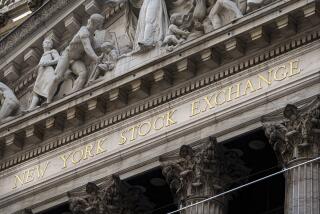Beware of Taking Short Ride on Long Bond
When everything goes right in financial markets, the magnitude of rallies can surprise even the biggest bulls. That’s what is happening now with 30-year Treasury bonds--securities that for most people are more useful as symbols than as actual investments.
If you’re thinking about hopping aboard this bandwagon, watch your step: As an investor, your objectives in buying a bond probably bear little resemblance to the goals of the speculators who appear to be driving the market today.
On Tuesday, heavy buying of 30-year T-bonds drove their yield down to 6.44% from 6.46% on Monday. Tuesday’s yield was just another in a long string of record-breaking lows for this bond in 1993. At the start of the year, the yield was 7.39%--nearly a full point higher.
Interest rates in general have been falling, of course, but the slide of the 30-year T-bond has been a particular fascination for Wall Street. Like the Dow Jones industrial average in the stock market, the 30-year T-bond yield is a benchmark for the bond market.
Because it represents the longest time span over which Uncle Sam borrows, the bond yield is a barometer of investors’ willingness to extend credit. In theory, it also reflects investors’ expectations about inflation--because the fixed rate on the bond means that your real return is only what’s left after inflation each year.
President Clinton, in pushing his federal deficit-reduction program through Congress, made the case that a legitimate attempt to cut the deficit would cause investors to lower their long-term inflation expectations. Then interest rates would fall as well, he boasted.
*
Is that what’s happening now? To a degree, yes--though it’s also evident that interest rates are easing partly because Wall Street expects Clinton’s tax hikes to slow the economy, reducing the demand for money.
There’s something else going on here. Because Clinton has made lower long-term interest rates such a major element of his economic policy, the Administration needed a backstop to make sure that rates went along with the program.
Thus, the Treasury decided last spring on another bold move: It would henceforth borrow less in long-term bonds and more in shorter-term securities. The net effect would be to make 30-year bonds scarcer--creating more competition for them among investors, putting added downward pressure on yields.
Last year, the Treasury sold 30-year bonds quarterly. That policy will end with Thursday’s planned sale of $11 billion in 30-year bonds. After that, these benchmark bonds will be sold only twice a year, and the next sale won’t be until February.
While it may seem odd that anything sold in volumes of $11 billion could become scarce, that notion is clearly motivating bond traders and investors to chase 30-year bonds now.
In addition, the bond is benefiting from outside factors that are purely coincidental: expectations of a deep decline in bond yields in recession-wracked Europe, for example, and rumors that the Brazilian government is actively buying T-bonds to be used as collateral (for bonds Brazil is issuing under the so-called Brady-bond debt restructuring program for Latin American nations).
Most of the T-bond buying frenzy, however, is unquestionably the work of U.S. portfolio managers and traders. Who, specifically, wants these bonds so badly?
One typical buyer is Michael Kennedy, manager of the $62-million SteinRoe Government Income bond mutual fund in Chicago. Because he expects long-term interest rates to continue falling in the near term, Kennedy has been selling seven-year Treasury notes out of his portfolio, replacing them with higher-yielding 30-year issues.
But Kennedy, like most fund managers, hardly expects to hold his 30-year bonds for the long haul. He says he’s likely to sell them in about six months--by which time he expects shorter-term interest rates to be rising with a growing economy, making the risk/reward trade-off on shorter-term bonds more appealing than that on 30-year issues.
*
That kind of thinking on the part of market pros is important for individuals to understand. Even if you believe that long-term yields can fall to 6% in the years ahead--as some pros do--getting there won’t be a straight line, as this rally suggests. Indeed, at the first sign that something’s amiss--higher inflation or some international shock--the supposed scarcity of 30-year bonds could quickly become a glut.
That’s because the longer this rally progresses, it becomes increasingly a speculator’s game. To put it another way, the mad rush into 30-year bonds today isn’t happening because the market believes 6.44% will be the highest interest rate available on such bonds for the next 30 years. Rather, many of the buyers are only along for the ride, until they perceive that it’s over.
Louis Crandall, chief economist at bond market consulting firm R.H. Wrightson & Associates in New York, says the surest sign that the 30-year bond now is being driven by speculators is the heavy recent demand for “stripped” Treasuries, which represent the principal-only portion of the bond. Such “stub” securities react with the greatest volatility to changes in market interest rates.
Demand for stripped T-bonds “suggests that it’s hot money driving the market,” Crandall said. “These are people who are just as concerned about how to (eventually) get out of a trade as how to get into it.”
Flattening Rates
The dramatic decline in long-term bond yield since December has narrowed the spread between those rates and shorter-term rates. In bond market parlance, the “yield curve” is flattening.
T-bill rates on a discount basis
More to Read
Inside the business of entertainment
The Wide Shot brings you news, analysis and insights on everything from streaming wars to production — and what it all means for the future.
You may occasionally receive promotional content from the Los Angeles Times.










